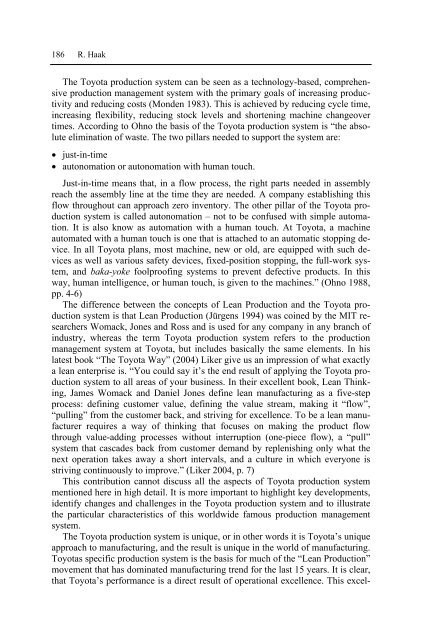Management of Technology and Innovation in Japan
Management of Technology and Innovation in Japan
Management of Technology and Innovation in Japan
You also want an ePaper? Increase the reach of your titles
YUMPU automatically turns print PDFs into web optimized ePapers that Google loves.
186 R. Haak<br />
The Toyota production system can be seen as a technology-based, comprehensive<br />
production management system with the primary goals <strong>of</strong> <strong>in</strong>creas<strong>in</strong>g productivity<br />
<strong>and</strong> reduc<strong>in</strong>g costs (Monden 1983). This is achieved by reduc<strong>in</strong>g cycle time,<br />
<strong>in</strong>creas<strong>in</strong>g flexibility, reduc<strong>in</strong>g stock levels <strong>and</strong> shorten<strong>in</strong>g mach<strong>in</strong>e changeover<br />
times. Accord<strong>in</strong>g to Ohno the basis <strong>of</strong> the Toyota production system is “the absolute<br />
elim<strong>in</strong>ation <strong>of</strong> waste. The two pillars needed to support the system are:<br />
� just-<strong>in</strong>-time<br />
� autonomation or autonomation with human touch.<br />
Just-<strong>in</strong>-time means that, <strong>in</strong> a flow process, the right parts needed <strong>in</strong> assembly<br />
reach the assembly l<strong>in</strong>e at the time they are needed. A company establish<strong>in</strong>g this<br />
flow throughout can approach zero <strong>in</strong>ventory. The other pillar <strong>of</strong> the Toyota production<br />
system is called autonomation – not to be confused with simple automation.<br />
It is also know as automation with a human touch. At Toyota, a mach<strong>in</strong>e<br />
automated with a human touch is one that is attached to an automatic stopp<strong>in</strong>g device.<br />
In all Toyota plans, most mach<strong>in</strong>e, new or old, are equipped with such devices<br />
as well as various safety devices, fixed-position stopp<strong>in</strong>g, the full-work system,<br />
<strong>and</strong> baka-yoke foolpro<strong>of</strong><strong>in</strong>g systems to prevent defective products. In this<br />
way, human <strong>in</strong>telligence, or human touch, is given to the mach<strong>in</strong>es.” (Ohno 1988,<br />
pp. 4-6)<br />
The difference between the concepts <strong>of</strong> Lean Production <strong>and</strong> the Toyota production<br />
system is that Lean Production (Jürgens 1994) was co<strong>in</strong>ed by the MIT researchers<br />
Womack, Jones <strong>and</strong> Ross <strong>and</strong> is used for any company <strong>in</strong> any branch <strong>of</strong><br />
<strong>in</strong>dustry, whereas the term Toyota production system refers to the production<br />
management system at Toyota, but <strong>in</strong>cludes basically the same elements. In his<br />
latest book “The Toyota Way” (2004) Liker give us an impression <strong>of</strong> what exactly<br />
a lean enterprise is. “You could say it’s the end result <strong>of</strong> apply<strong>in</strong>g the Toyota production<br />
system to all areas <strong>of</strong> your bus<strong>in</strong>ess. In their excellent book, Lean Th<strong>in</strong>k<strong>in</strong>g,<br />
James Womack <strong>and</strong> Daniel Jones def<strong>in</strong>e lean manufactur<strong>in</strong>g as a five-step<br />
process: def<strong>in</strong><strong>in</strong>g customer value, def<strong>in</strong><strong>in</strong>g the value stream, mak<strong>in</strong>g it “flow”,<br />
“pull<strong>in</strong>g” from the customer back, <strong>and</strong> striv<strong>in</strong>g for excellence. To be a lean manufacturer<br />
requires a way <strong>of</strong> th<strong>in</strong>k<strong>in</strong>g that focuses on mak<strong>in</strong>g the product flow<br />
through value-add<strong>in</strong>g processes without <strong>in</strong>terruption (one-piece flow), a “pull”<br />
system that cascades back from customer dem<strong>and</strong> by replenish<strong>in</strong>g only what the<br />
next operation takes away a short <strong>in</strong>tervals, <strong>and</strong> a culture <strong>in</strong> which everyone is<br />
striv<strong>in</strong>g cont<strong>in</strong>uously to improve.” (Liker 2004, p. 7)<br />
This contribution cannot discuss all the aspects <strong>of</strong> Toyota production system<br />
mentioned here <strong>in</strong> high detail. It is more important to highlight key developments,<br />
identify changes <strong>and</strong> challenges <strong>in</strong> the Toyota production system <strong>and</strong> to illustrate<br />
the particular characteristics <strong>of</strong> this worldwide famous production management<br />
system.<br />
The Toyota production system is unique, or <strong>in</strong> other words it is Toyota’s unique<br />
approach to manufactur<strong>in</strong>g, <strong>and</strong> the result is unique <strong>in</strong> the world <strong>of</strong> manufactur<strong>in</strong>g.<br />
Toyotas specific production system is the basis for much <strong>of</strong> the “Lean Production”<br />
movement that has dom<strong>in</strong>ated manufactur<strong>in</strong>g trend for the last 15 years. It is clear,<br />
that Toyota’s performance is a direct result <strong>of</strong> operational excellence. This excel-


